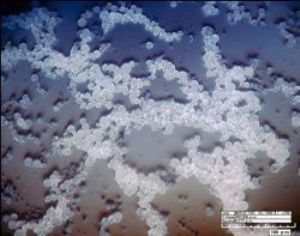Jun 6 2013
If you’ve been on or near the water, you’ve seen it—the plastic trash that litters oceans, lakes, and streams worldwide. But visible plastic—soda bottles, lighters, flip-flops, combs, rope—may be the least of the problem. Scientists are beginning to realize that what you can’t see, tiny bits of polyethylene or polypropylene called “microplastics,” likely pose a greater threat to marine ecosystems.
 A photomicrograph of PHA microbeads created at VIMS. Scale is in microns (millionths of a meter). (Photo courtesy of Jason McDevitt, Applied Research Center.)
A photomicrograph of PHA microbeads created at VIMS. Scale is in microns (millionths of a meter). (Photo courtesy of Jason McDevitt, Applied Research Center.)
Now, a grant to researchers at the Virginia Institute of Marine Science will help them develop and test a biodegradable replacement for one of the two main sources of microplastic—the “microbeads” found in scores of household products such as toothpaste, sunscreen, shampoo, soap, lip gloss, and moisturizers. Microplastics also form from the breakdown of larger pieces of plastic trash.
The $60,000 grant, from the Virginia Innovation Partnership, was awarded to VIMS researchers Dr. Kirk Havens and assistant professor Donna Bilkovic. They’ll collaborate on the project with Drs. Jason McDevitt, Director of William & Mary’s Technology Transfer Office, Charles Bott of the Hampton Roads Sanitation District, and David Holbrook of the National Institute of Standards and Technology in Gaithersburg, Maryland. The merit of the project was recognized with a TechConnect Innovation Award during the recent TechConnect-National Innovation Summit in Washington, D.C.
“Microplastics have become a big concern in the world’s oceans and estuaries,” says Havens. “We already know that larger plastic items can harm organisms like turtles, seabirds, and fish by interfering with digestion or through strangulation; a concern with microplastics is that they’re even more widely dispersed, and small enough to be eaten by a much more diverse group of organisms. Once ingested, these compounds and anything they’ve absorbed can be magnified up the food chain.”
VIMS professor Rob Hale, an expert on marine toxic chemicals, says in an interview with Bay Journal reporter Karl Blankenship, “Depending on their size and composition, plastics may release previously bound-up chemicals into the water as they break into particles. At the same time, limited research suggests the changing composition of the smaller plastic bits may make it easier for them to absorb other chemicals that may be in the water.” Tests have shown that some small plastic particles readily take up persistent organic pollutants such as polychlorinated biphenyls (PCBs) and the now-banned insecticide DDT.
“When something comes along and eats [a piece of microplastic],” Hale adds, "they have basically ingested a pill of chemicals." To date, scientists have found evidence of ingestion of microplastics by marine worms, tiny crustacean grazers like amphipods, and filter feeders like mussels and barnacles.
Biodegradable Microbeads
To address the microplastic problem, Havens, Bilkovic, and colleagues Kory Angstadt and David Stanhope are working to develop microbeads from a family of naturally occurring “biopolyesters” that are produced by several types of soil-dwelling bacteria. Previous tests have shown that these compounds—known as PHAs—are completely biodegradable by microbes typically found in seawater, which break them down into water, carbon dioxide, and other simple molecules.
Equally important, PHAs appear to have the properties needed for use in cosmetic products, including the ability to provide a slightly gritty feel for skin cleansers and toothpaste, and to reduce the appearance of wrinkles through “optical blurring.” Sales of cosmetics and toiletries topped $36 billion in the United States in 2010, with skin-care products accounting for 25% of the total.
Another important property of PHAs is that they are slightly more dense than the plastics in current microbeads. “PHAs sink in water,” says Havens. “That makes them more likely to biodegrade in septic tanks and wastewater treatment plants. The plastics in current microbeads are buoyant, increasing their chance of floating right through septic and sewage systems and into estuaries and other marine ecosystems.”
This isn't the first time that the VIMS team has turned to PHA, having used it previously to develop a biodegradable panel that is now commercially available to address the problem of continued fishing by abandoned crab pots and lobster traps. Previous research by the team revealed that Chesapeake Bay watermen lose about 20% of their crab pots to storms and boat propellers each year. Outfitting these metal-mesh “ghost pots” with a biodegradable escape hatch allows any marine life that might enter such a pot to subsequently swim free.
For the current project, the VIMS team has already begun creating batches of microbeads in the laboratory, testing various formulations and processes for producing beads of different color and size—from 1 to 100 microns (a typical human hair is about 100 microns across).
The team’s next step is to collaborate with Charles Bott of the Hampton Roads Sanitation District and his “sequencing batch reactor”—essentially a lab-sized wastewater treatment plant—to test how completely their microbeads will biodegrade in this setting. Dr. David Holbrook of the National Institute of Standards and Technology will provide expertise and the specialized instruments needed to determine how fast PHAs might disappear from the wastewater stream.
“The idea,” says Havens, “is that our microbeads will biodegrade quickly, within septic tanks, wastewater treatment plants, and smaller tributaries; before they ever reach the Bay. It's a proactive approach to reducing microplastic pollution.”